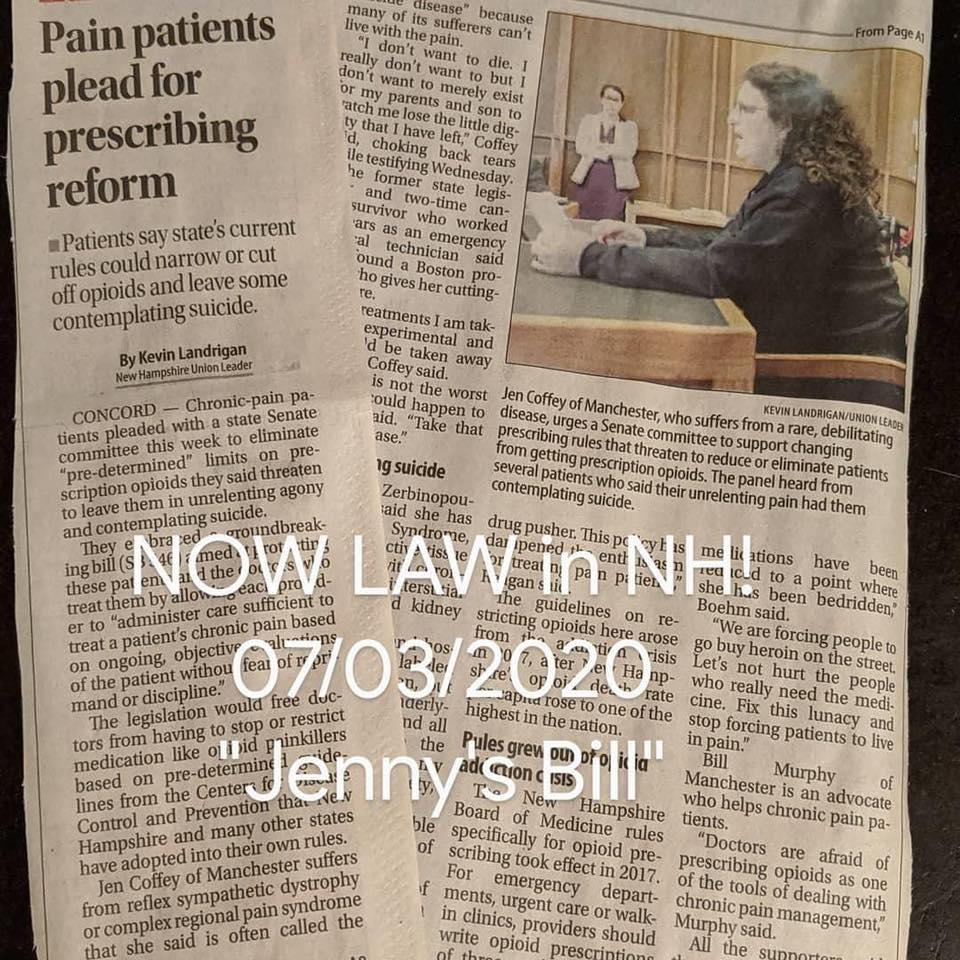39:18 New Paragraph; Definition Added; Controlled Drug Prescription Health and Safety Program. Amend RSA 318-B:31 by inserting after paragraph I the following new paragraph: I-a.(a) “Chronic pain” means a state in which pain persists beyond the usual course of an acute disease or healing of an injury, or that might or might not be associated with an acute or chronic pathologic process that causes continuous or intermittent pain over months or years. It also includes intermittent episodic pain that might require periodic treatment. (1) For the purpose of this subdivision, chronic pain does not cover or in any way determine treatment for pain from terminal disease. (2) For the purpose of this subdivision, chronic pain includes but may not be limited to pain defined as “chronic,” “intractable,” “high impact,” “chronic episodic,” and “chronic relapsing.” (b) A diagnosis of chronic pain made by a practitioner licensed in any of the states in the United States or the District of Columbia and supported by written documentation of the diagnosis by the treating practitioner shall constitute proof that the patient suffers from chronic pain. 39:19 New Subparagraph; Controlled Drug Prescription Health and Safety Program; Standards for Treatment of Chronic Pain. Amend RSA 318-B:41, II by inserting after subparagraph (c) the following new subparagraph: (d) In addition to the provisions of subparagraph (c), standards for the use of opioids for the management or treatment of chronic pain, which shall include the following: (1) All decisions regarding the treatment of patients experiencing chronic pain shall be made by the treating practitioner even when the treatment is determined to require the prescribing of opioid analgesics. Treating practitioners shall administer care sufficient to treat a patient’s chronic pain based on ongoing, objective evaluations of the patient without fear of reprimand or discipline. (2) Ordering, prescribing, dispensing, administering, or paying for controlled substances, including opioid analgesics, shall not in any way be pre-determined by specific Morphine Milligram Equivalent (MME) guidelines.
– Page 9 – (3) Ongoing treatment of those patients who experience chronic pain can be determined, managed, and administered by: (A) A pain management practitioner who specializes in the treatment of chronic pain; or (B) A practitioner who specializes in the illness or injury from which the patient suffers; or (C) The patient’s primary care practitioner who shall document the consideration of a consultation with a practitioner who specializes in the treatment of the patient’s specific illness or injury or a pain management practitioner. (4) For the patient who experiences chronic illness or injury and resulting chronic pain, documentation of the health issue must be provided and held in the patient’s file. (5) When treating a patient who experiences chronic illness or injury and resulting chronic pain, the prescribing of opioid analgesics shall be done in a measured and monitored manner and administered in the lowest amount necessary to control pain. (6) Once an opioid analgesic is prescribed to treat chronic illness or injury and resulting chronic pain, the prescription shall be monitored closely by the prescriber and titrated as ongoing, objective evaluations of said patient’s injury or illness requires for ongoing, successful treatment. (7) For those patients who experience chronic illness or injury and resulting chronic pain who are on a managed and monitored regimen of opioid analgesic treatment and have increased functionality and quality of life as a result of said treatment, treatment shall be continued if there remains no indication of misuse or diversion. (8) Proper documentation from the practitioner related to the filling of a prescription under this subparagraph shall be provided to the pharmacist upon the initial filling of the prescription, or upon request of the pharmacist. (9) The rules necessary to effectuate the provisions of this subparagraph governing pain management associated with chronic pain shall: (A) Take into consideration the individualized needs of patients covered by this subparagraph; (B) Make provisions for practitioners, acting in good faith, and in the course of their profession, and managing chronic pain associated with their patients’ illness to use their best judgment notwithstanding any statute or rule to the contrary; and (C) Ensure that patients covered by this section are treated with dignity and not unduly denied the medications needed to treat their conditions.

